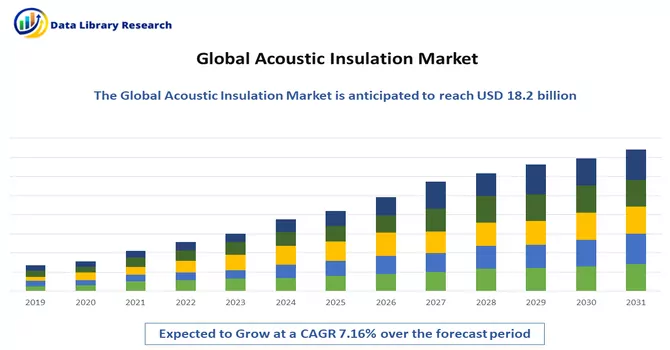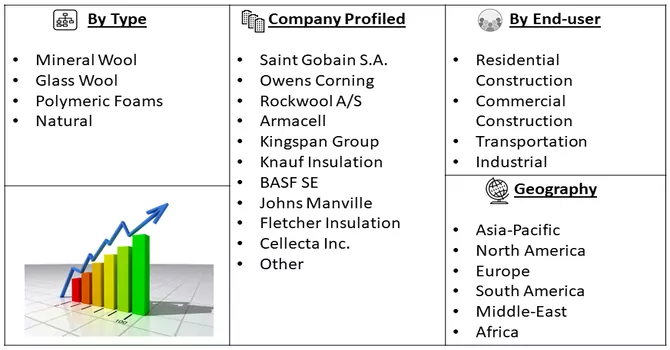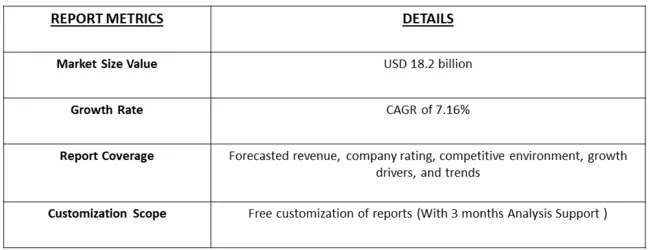The Acoustic Insulation Market size is estimated at USD 18.2 billion in 2024 and is expected to reach a CAGR of 7.16% over the forecast period, 2024-2031.

Get Complete Analysis Of The Report - Download Free Sample PDF
Acoustic insulation plays a pivotal role in the contemporary construction and manufacturing landscape, serving as a critical solution to mitigate unwanted noise and enhance sound quality in diverse environments. As the demand for noise control and acoustic comfort continues to rise, the acoustic insulation market is witnessing significant growth. Key sectors such as residential and commercial construction, automotive manufacturing, and industrial facilities increasingly prioritize the incorporation of acoustic insulation materials to meet stringent noise regulations and create conducive and comfortable spaces. The market is characterized by a diverse range of materials, including fibreglass, mineral wool, foams, and recycled materials, each offering specific acoustic performance attributes. With a focus on creating quieter and more efficient spaces, the acoustic insulation market aligns with the broader trends towards sustainable, energy-efficient, and noise-conscious solutions in modern architecture and manufacturing.
The burgeoning demand for acoustic insulation is propelled by a confluence of factors, with the primary driver being the escalating need for noise control solutions across various industries. In the construction sector, there is a growing emphasis on creating soundproof and comfortable living or working spaces, driven by urbanization, population density, and stringent noise regulations. Additionally, the automotive industry's increasing focus on enhancing vehicle cabin comfort and complying with noise reduction standards contributes significantly to the demand for acoustic insulation materials. The relentless pursuit of energy efficiency and sustainability in building design further augments the market, as acoustic insulation plays a crucial role in creating environmentally conscious structures. With an evolving landscape that prioritizes noise reduction for human well-being and regulatory compliance, the acoustic insulation market is poised for sustained growth, driven by its integral role in shaping quieter and more comfortable environments across diverse sectors.
Market segmentation: Acoustic Insulation Manufacturers and the market is segmented by Type (Mineral Wool, Glass Wool, Polymeric Foams, and Natural), End-user Industry (Residential Construction, Commercial Construction, Transportation, and Industrial), and Geography (Asia-Pacific, North America, Europe, South America, and Middle East and Africa). The market size and forecasts for Acoustic Insulation are Provided in revenue (USD million) for all the above segments.

For Detailed Market Segmentation - Download Free Sample PDF
Market trends in the acoustic insulation sector reflect a dynamic landscape shaped by evolving consumer preferences and industry advancements. One notable trend is the increasing adoption of sustainable and eco-friendly insulation materials, aligning with broader environmental consciousness. Manufacturers are exploring recycled and bio-based materials to meet the demand for greener alternatives in construction and manufacturing. Another trend involves innovations in technology and material science, leading to the development of advanced acoustic insulation solutions with enhanced performance characteristics. The customization of acoustic solutions for specific applications, such as residential, commercial, and industrial settings, is gaining prominence. Additionally, the integration of smart acoustic technologies, offering real-time monitoring and adjustment of sound levels, is emerging as a key trend. As the market continues to evolve, these trends underscore a shift towards more sophisticated, sustainable, and tailored acoustic insulation solutions to meet the diverse and evolving needs of the modern built environment.
Market Drivers:
As urbanization intensifies, the need for effective noise control solutions in residential and commercial construction becomes more critical
As urbanization intensifies globally, the imperative for effective noise control solutions in residential and commercial construction becomes increasingly critical. The rising population density in urban areas and the proliferation of commercial spaces amplify noise levels, impacting the quality of living and working environments. Acoustic insulation plays a pivotal role in addressing this challenge by mitigating unwanted sound transmission and creating more comfortable, quieter spaces. As cities expand and construction activity accelerates, the demand for innovative and efficient noise control solutions continues to grow. Developers, architects, and homeowners are placing heightened emphasis on integrating acoustic insulation materials into building designs to ensure a harmonious coexistence with the urban surroundings, underscoring the vital role of acoustic solutions in fostering quieter and more livable urban spaces.
Regulatory standards for noise reduction in various sectors
Regulatory standards for noise reduction have become increasingly stringent across various sectors, ushering in a new era of emphasis on sound control and environmental health. In industries such as construction, manufacturing, and transportation, governing bodies are imposing stricter guidelines to limit noise pollution. These regulations aim to mitigate the adverse effects of noise on both the workforce and the surrounding communities. As a result, there is a heightened focus on incorporating advanced acoustic insulation materials and technologies to ensure compliance with these standards. The imperative for industries to adhere to noise reduction regulations not only aligns with broader environmental goals but also fosters the development and adoption of innovative solutions, driving the growth of the acoustic insulation market as an integral component in meeting and exceeding these evolving regulatory expectations.
Market Restraints:
The acoustic insulation market faces several constraints that influence its dynamics. One significant restraint is the cost associated with high-performance acoustic insulation materials and technologies. Premium materials designed for superior sound control may pose budgetary challenges for certain construction projects or industries, impacting the widespread adoption of advanced acoustic solutions. Additionally, the diversity in building designs, materials, and acoustic requirements creates a complex landscape, making it challenging to develop one-size-fits-all solutions. Moreover, the inertia in the retrofitting of existing structures with acoustic insulation due to cost implications and logistical challenges poses a restraint on market growth. Furthermore, the variability in regulatory standards across regions and industries can create ambiguity and hinder a standardized approach to acoustic insulation. Overcoming these challenges requires innovative and cost-effective solutions to make advanced acoustic insulation accessible and applicable across diverse settings.
The COVID-19 pandemic has had nuanced impacts on the acoustic insulation market. While the initial disruptions in supply chains and construction activities during lockdowns temporarily slowed the market, the subsequent paradigm shift in remote work and the increased focus on indoor environments revitalized interest in acoustic solutions. As people spent more time at home, there emerged a heightened awareness of the importance of acoustics in creating conducive living and working spaces. This led to a surge in demand for acoustic insulation materials for home offices, residential spaces, and retrofitting projects. However, challenges such as economic uncertainties and construction delays affected certain segments of the market. As the global community transitions to a post-pandemic phase, the acoustic insulation market is expected to rebound, driven by the enduring significance of noise control in the evolving dynamics of the built environment.
Segmental Analysis:
Mineral Wool Segment is Expected to Witness Significant Growth over the Forecast Period
The Mineral Wool and Acoustic Insulation Market is witnessing substantial growth as the construction and industrial sectors prioritize energy efficiency and sound control. Mineral wool, a key component in acoustic insulation materials, offers excellent thermal and acoustic properties, making it a preferred choice for various applications. The market is driven by a growing awareness of the importance of efficient insulation in reducing energy consumption and minimizing sound transmission. As industries and construction projects seek sustainable and eco-friendly solutions, mineral wool emerges as a versatile material that meets stringent performance standards. The increasing emphasis on creating healthier and quieter indoor environments further propels the demand for acoustic insulation solutions, driving the Mineral Wool and Acoustic Insulation Market. With innovations in product formulations and applications, this market is poised to play a crucial role in addressing contemporary challenges related to energy conservation and noise control across diverse sectors.
Residential Construction Segment is Expected to Witness Significant Growth over the Forecast Period
The Residential Construction and Acoustic Insulation Market are intricately linked as the demand for noise control solutions in residential structures continues to rise. As homeowners increasingly prioritize comfort and peaceful living environments, acoustic insulation plays a pivotal role in dampening sound transmission and enhancing the overall quality of life. The market is witnessing a surge in demand for innovative acoustic insulation materials that strike a balance between performance, sustainability, and ease of installation in residential construction projects. With a growing focus on creating energy-efficient and environmentally friendly homes, acoustic insulation materials contribute significantly to meeting stringent building codes and improving overall thermal comfort. As the residential construction sector evolves to cater to modern living standards, the Acoustic Insulation Market adapts with innovative solutions, positioning itself as an integral component in enhancing the acoustic performance of homes and ensuring a quiet and serene living experience for homeowners.
North America Region is Expected to Witness Significant Growth over the Forecast Period
In North America, the Acoustic Insulation Market is witnessing substantial growth driven by the region's emphasis on creating soundproof and energy-efficient environments across various sectors. The construction industry, in particular, is increasingly incorporating advanced acoustic insulation solutions to meet stringent regulations and address the rising demand for noise control in residential, commercial, and industrial spaces. With a growing awareness of the impact of noise pollution on well-being, North America is witnessing a surge in the adoption of innovative acoustic materials that strike a balance between performance, sustainability, and cost-effectiveness. The region's commitment to sustainable building practices and energy efficiency aligns with the advancements in acoustic insulation technologies, positioning North America as a significant player in shaping the trajectory of the Acoustic Insulation Market. As industries and consumers alike prioritize comfort and environmental consciousness, the North American market for acoustic insulation continues to evolve, with a focus on meeting the evolving needs of a noise-conscious and eco-friendly society.

Get Complete Analysis Of The Report - Download Free Sample PDF
The analyzed market exhibits a high degree of fragmentation, primarily attributable to the presence of numerous players operating on both a global and regional scale. The competitive landscape is characterized by a diverse array of companies, each contributing to the overall market dynamics. This fragmentation arises from the existence of specialized solution providers, established industry players, and emerging entrants, all vying for market share. The diversity in market participants is underscored by the adoption of various strategies aimed at expanding the company presence. On a global scale, companies within the studied market are strategically positioning themselves through aggressive expansion initiatives. This often involves entering new geographical regions, targeting untapped markets, and establishing a robust global footprint. The pursuit of global expansion is driven by the recognition of diverse market opportunities and the desire to capitalize on emerging trends and demands across different regions. Simultaneously, at the regional level, companies are tailoring their approaches to align with local market dynamics. Regional players are leveraging their understanding of specific market nuances, regulatory environments, and consumer preferences to gain a competitive edge. This regional focus allows companies to cater to the unique needs of local clientele, fostering stronger market penetration. To navigate the complexities of the fragmented market, companies are implementing a range of strategies. These strategies include investments in research and development to stay at the forefront of technological advancements, mergers and acquisitions to consolidate market share, strategic partnerships for synergies, and innovation to differentiate products and services. The adoption of such multifaceted strategies reflects the competitive nature of the market, with participants continually seeking avenues for growth and sustainability. In essence, the high fragmentation in the studied market not only signifies the diversity of players but also underscores the dynamism and competitiveness that drive ongoing strategic maneuvers. As companies explore various avenues for expansion, the market continues to evolve, presenting both challenges and opportunities for industry stakeholders.
Recent Development:
1) In May 2023, UPM Biochemicals and URSA, a prominent European producer of glass wool and mineral wool, jointly unveiled a groundbreaking initiative aimed at advancing eco-friendly building insulation, with a direct impact on reducing energy consumption and decreasing CO2 emissions. This collaborative effort involves URSA's production of sustainable glass wool, incorporating an inventive binder derived from UPM BioPiva™ lignin. This development positions the product as one of the most environmentally conscious insulation materials currently accessible in the market. The incorporation of UPM BioPiva™ lignin not only signifies a notable stride towards sustainability but also underscores a commitment to providing the construction industry with insulation solutions that align with the evolving standards of eco-friendly and energy-efficient building practices. This innovation is poised to contribute significantly to the insulation materials market by offering a natural and effective alternative, reflecting the industry's responsiveness to environmental concerns and the growing demand for sustainable construction solutions.
Q1. What is the current Acoustic Insulation Market size?
As per Data Library Research the Acoustic Insulation Market size is currently estimated at USD 18.2 billion.
Q2. At what CAGR is the Acoustic Insulation Market projected to grow within the forecast period?
Acoustic Insulation Market is expected to reach a CAGR of 7.16% over the forecast period.
Q3. Which Region is expected to hold the highest Market share?
North America region is expected to hold the highest Market share.
Q4. Who are the key players in Acoustic Insulation Market ?
Some key players operating in the market include
Data Library Research are conducted by industry experts who offer insight on industry structure, market segmentations technology assessment and competitive landscape (CL), and penetration, as well as on emerging trends. Their analysis is based on primary interviews (~ 80%) and secondary research (~ 20%) as well as years of professional expertise in their respective industries. Adding to this, by analysing historical trends and current market positions, our analysts predict where the market will be headed for the next five years. Furthermore, the varying trends of segment & categories geographically presented are also studied and the estimated based on the primary & secondary research.
In this particular report from the supply side Data Library Research has conducted primary surveys (interviews) with the key level executives (VP, CEO’s, Marketing Director, Business Development Manager and SOFT) of the companies that active & prominent as well as the midsized organization
FIGURE 1: DLR RESEARH PROCESS

Extensive primary research was conducted to gain a deeper insight of the market and industry performance. The analysis is based on both primary and secondary research as well as years of professional expertise in the respective industries.
In addition to analysing current and historical trends, our analysts predict where the market is headed over the next five years.
It varies by segment for these categories geographically presented in the list of market tables. Speaking about this particular report we have conducted primary surveys (interviews) with the key level executives (VP, CEO’s, Marketing Director, Business Development Manager and many more) of the major players active in the market.
Secondary ResearchSecondary research was mainly used to collect and identify information useful for the extensive, technical, market-oriented, and Friend’s study of the Global Extra Neutral Alcohol. It was also used to obtain key information about major players, market classification and segmentation according to the industry trends, geographical markets, and developments related to the market and technology perspectives. For this study, analysts have gathered information from various credible sources, such as annual reports, sec filings, journals, white papers, SOFT presentations, and company web sites.
Market Size EstimationBoth, top-down and bottom-up approaches were used to estimate and validate the size of the Global market and to estimate the size of various other dependent submarkets in the overall Extra Neutral Alcohol. The key players in the market were identified through secondary research and their market contributions in the respective geographies were determined through primary and secondary research.
Forecast Model
